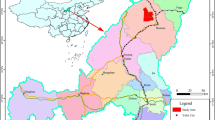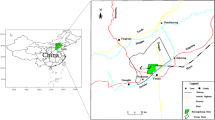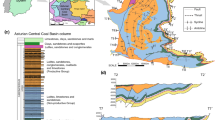Abstract
Coal and water resources have played important roles in China’s social and economic development. Thus, accurate and reliable predictions of coal mine water inflow and aquifer water level variations are required to ensure mining safety and assess the impact of coal mining on groundwater aquifers. A three-dimensional numerical model was established for unsteady groundwater flows based on a conceptual hydrogeologic model. The numerical simulation predicted mine water inflow via repeated parameter adjustments and model identification and verification, and the simulated water inflow values were compared with the water inflow values predicted by the hydrogeological analytical method. Similarly, the numerical simulation also forecasted the changes in the water levels of the phreatic and karst fissure aquifers. The numerical simulation predicted greater water inflow than that determined by the big well method for the 5th coal seam of Panel 1, whereas the opposite results were obtained for the water inflow estimates for the coal seams in the other two panels. The calculated combined mine water inflows for the three mined panels were 14940 m3/day and 14774 m3/day using the big well method and the numerical simulation, respectively. A comparative analysis of the water levels in different periods showed that the water levels slightly decreased for both the mined and unmined cases, and the maximum variation differences between the unmined and mined cases were 1.39 and 2.72 m in the phreatic aquifer and karst fissure aquifer, respectively. The maximum water level decrease occurred in the northeast area of the coalfield. Based on this work, such results can be used by decision maker to improve mine safety and protect water resources.







Similar content being viewed by others
References
Bredehoeft J (2005) The conceptualization model problem-surprise. Hydrogeol J 13:37–46
Bukowski P (2011) Water hazard assessment in active shafts in upper silesian coal basin mines. Mine Water Environ 30:302–311
Chen MZ, Liu SC, Yang GY (2009) The development of mining water inflow predict method. Chin J Eng Geophys 1:68–72 (in Chinese)
China National Bureau of Coal Industry (2017) Rules for the mine extraction and coal pillars establishment under buildings, water bodies, railways and main laneways. China Coal Industry Publishing House, Beijing
Cidu R, Biddau R, Fanfani L (2009) Impact of past mining activity on the quality of groundwater in SW Sardinia (Italy). J Geochem Explor 100:125–132
Dhakate R, Singh VS, Hodlur GK (2008) Impact assessment of chromite mining on groundwater through simulation modeling study in Sukinda chromite mining area, Orissa, India. J Hazard Mater 160:535–547
Guo H, Adhikary DP, Craig MS (2009) Simulation of mine water inflow and gas emission during longwall mining. Rock Mech Rock Eng 42:25–51
Hu WY, Yan L (2016) Analysis and consideration on prediction problems of mine water inflow volume. Coal Sci Technol 1:13–18 (38 [in Chinese])
Kazemi GA (2012) Hydrogeology-a global perspective || conceptual models in hydrogeology, methodology and results. 10.5772/1523 (Chapter 7)
Li GC (2013) Application of numerical simulation in coal mine water inflow calculation. Coal Technol 2:115–117 (in Chinese)
Li WP, Liu ZY, Guo HP, Li N, Kang WD (2011) Simulation of groundwater fall caused by geological discontinuities. Hydrogeol J 19:1121–1133
Li TX, Song HQ, Huang G, Bi Y, Li XY (2014) Assessment of groundwater changing trends through the generalized large well method with confined–unconfined flow model in open-pit mine area. Environ Earth Sci 72:4599–4606
Li S, Xu F, Zhang Q (2015) Analysis and construction techniques for a water seal for underground mines subjected to water inrush. Mine Water Environ 35:1–12
Luo ZG, Li Z, Ren HJ (2015) Numerical Simulation Research on Prediction of Mine Inflow. Coal Sci Technol 43:33–36 (in Chinese)
Mengistu H, Tessema A, Abiye T, Demlie M, Lin HL (2015) Numerical modeling and environmental isotope methods in integrated mine-water management: a case study from the Witwatersrand basin, South Africa. Hydrogeol J 23:533–550
Miladinović B, Vakanjac VR, Bukumirivić D (2015) Simulation of mine water inflow: Case study of the Štavalj coal mine (Southwestern Serbia). Arch Min Sci 60:955–969
Polak K, Różkowski K, Czaja P (2016) Causes and effects of uncontrolled water inrush into a decommissoned mine shaft. Mine Water Enviorn 35:128–135
Qiao XL, Li GM, Li M, Zhou JL, Du J, Du CY, Sun ZH (2011) Influence of coal mining on regional karst groundwater system: a case study in West Mountain area of Taiyuan City, northern China. Environ Earth Sci 64:1525–1535
Rupp DE, Schmidt J, Woods RA, Bidwell VJ (2009) Analytical assessment and parameter estimation of a low-dimensional groundwater model. J Hydrol 377:143–154
Shabanimashcool M, Li CC (2012) Numerical modelling of longwall mining and stability analysis of the gates in a coal mine. Int J Rock Mech Min Sci 51:24–34
Singh VP, Woolhiser DA (2002) Mathematical modelling of watershed hydrology. J Hydrol Eng 7:270–292
Su WJ, Wu Q, Liu HL (2015) Prediction and assessment of the disturbances of the coal mining in Kailuan to karst groundwater system. Phys Chem Earth Parts A B C 89–90:136–144
Sun WJ, Wu Q, Dong DL, Jian J (2012) Avoiding coal-water conflicts during the development of China’s large coal-producing regions. Mine Water Environ 31:74–78
Sun WJ, Wu Q, Liu HL, Jian J (2015) Prediction and assessment of the disturbances of the coal mining in Kailuan to karst groundwater system. Phys Chem Earth 89–90:136–144
Surinaidu L, Gurunadha RVVS, Srinivasa RN (2014) Hydrogeological and groundwater modeling studies to estimate the groundwater inflows into the coal mines at different mine development stages using MODFLOW, Andhra Pradesh, India. Water Res Indus 7–8:49–65
Vandenbohede A, Hinsby K, Courtens C, Lebbe L (2011) Flow and transport model of a polder area in the Belgian coastal plain: example of data integration. Hydrogeol J 19:1599–1615
Wang P, Yu JJ, Zhang YC, Fu GB, Min LL, Ao F (2011) Impacts of environmental flow controls on the water table and groundwater chemistry in the Ejina Delta, northwestern China. Environ Earth Sci 64:15–24
Wu Q, Zhou WF (2008) Prediction of inflow from overlying aquifers into coalmines: a case study in Jinggezhuang Coalmine, Kailuan, China. Environ Geol 55:775–780
Wu Q, Zhou WF, Wang JH, Xie SH (2009) Prediction of groundwater inrush into coal mines from aquifers underlying the coal seams in China: application of vulnerability index method to Zhangcun Coal Mine, China. Environ Geol 57:1187–1195
Wu Q, Xu K, Zhang W, Wei Z (2017) Roof aquifer water abundance evaluation: a case study in Taigemiao, China. Arabian J Geosci 10:254
Yang YG, Wang J, Yu YJ (2015) Effects of different coal safe mining sequence under river on height of water flowing fracture zone. J Chi Coal Soc 40:27–32 (in Chinese)
Yihdego Y, Paffard A (2017) Predicting open pit mine inflow and recovery depth in the Durvuljin soum, Zavkhan Province, Mongolia. Mine Water Environ 36:114–123
Yin HY, Wei JC, Lefticariu L, Guo JB, Xie DL, Li ZL, Zhao P (2016) Numerical simulation of water flow from the coal seam floor in a deep longwall mine in China. Mine Water Environ 35:243–252
Zhang K, Cao B, Lin G, Zhao MD (2017) Using multiple methods to predict mine water inflow in the Pingdingshan No.10 coal mine, China. Mine Water Environ 36:154–160
Acknowledgements
This study was supported by a project supported by the Ministry of Land and Resources of China (201511056-3), the National Natural Science Foundation of China (no. 41572227) and a project supported by Department of Land and Resources of Anhui Province (2016-k-10).
Author information
Authors and Affiliations
Corresponding author
Additional information
Publisher’s Note
Springer Nature remains neutral with regard to jurisdictional claims in published maps and institutional affiliations.
Rights and permissions
About this article
Cite this article
Wu, C., Wu, X., Zhu, G. et al. Predicting mine water inflow and groundwater levels for coal mining operations in the Pangpangta coalfield, China. Environ Earth Sci 78, 130 (2019). https://doi.org/10.1007/s12665-019-8098-2
Received:
Accepted:
Published:
DOI: https://doi.org/10.1007/s12665-019-8098-2




